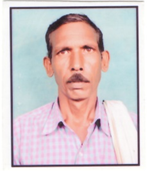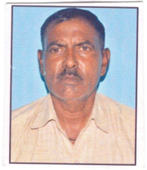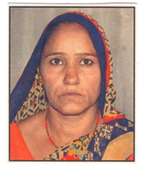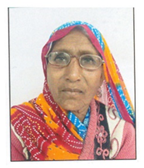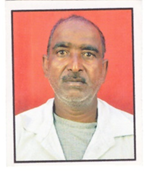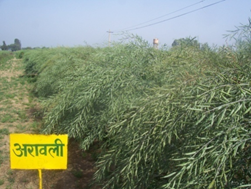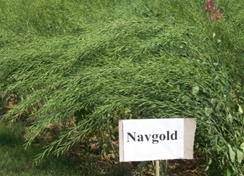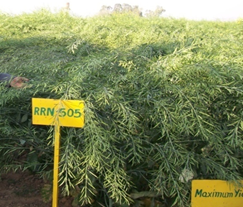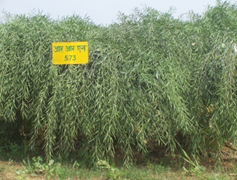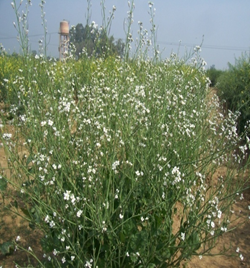Quick Links
- Download Form 16/16A
- Downloads/Publications
- Anti-Ragging
- RTI
- Central Library
- Results
- Official Directories
- SKNAU IHE Portal
- SKN Agri-Business Incubator (S-ABI), Jobner
- NAHEP IDP
- Faculty Profiles (AEIS)
- Annual/Self Study Report
- Jobner Krishi
- Video Lectures
- Grievance Management
- Agri-DIKSHA
- MoU
- AMS
- NARES-BLP
- NIRF Data 2025
ARS, Navgaon
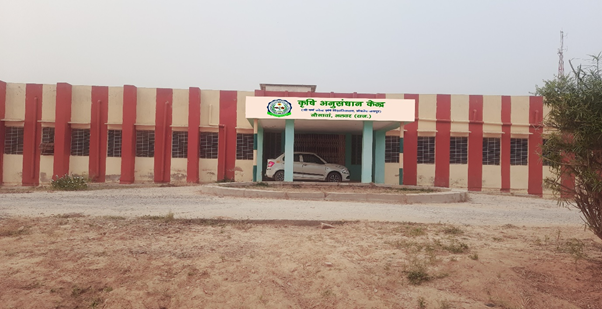
About ARS
Agriculture Research Station (ARS), Navgaon, Alwar is constituent research station of Sri Karan Narendra Agriculture University,Jobner.This station is located 32 km from the Alwar Junction on the Sohna-Alwar Highway. It is 128 km away from Indira Gandhi International Airport, New Delhi and 175 km from Jaipur international airport. The station is situated at 27º38'54" N latitude and 76º51'58" Elongitude and 251 m above from mean sea level (MSL). This station has frontier in agriculture research since its inception and is an important research station of the university.
The centre was established by the State Department of Agriculture as a Seed Multiplication Farm in late fifties. The main objective was to multiply foundation and certified seeds of principal crops of the area. Research scheme on oilseeds and pulses (Non-Plan) was sanctioned in 1974-75 and the work of varietal screening and testing was initiated in Rapeseed-Mustard. In 1976, with the transfer of agricultural research to the university from state department of agriculture, the centre became Agricultural Research Sub Station, a constituent unit of the then Sukhadia University, Udaipur and later elevated to main station (Agricultural Research Station) with lead research functions on pulses and oilseeds. In 1981, a project on Intensification of Research and Training on Oilseeds and Pulses was sanctioned by ICAR to work out agronomic practices and rural social activities related to rapeseed–mustard and pulse crops. At this juncture NARP came into existence with an objective of strengthening the research capabilities of the station for solving location specific problems. The mandate of research was specified. In 1984, All India Coordinated Research Project on Oilseeds Improvement (R&M) was transferred from ARS, Durgapura, Jaipur to ARS, Navgaon, Alwar with the main responsibility of improvement of Rapeseed-Mustard group of crops in the state. A sub unit of the station was subsequently established at Kumher (Bharatpur) as Agriculture Research Sub Station in 1989, however, the sub-station became operative only in 1992 after completion of the formalities of acquisition of land allotted to it by the state government.
To conduct basic, strategic and applied research for sustainable development of agriculture sector.
To develop improved varieties of agricultural crops especially rapeseed & mustard.
To develop package of practices for important agricultural crops of the zone.
To produce and supply breeder seed of different crops for production of different categories of seed.
Mandates
Planning and conducting research as per the basic needs of the farmers.
Development and testing the improved high yielding verities of important agricultural crops.
Establishment of coordination with agricultural department and extension functionaries to streamline research and extension activities of the zone.
Production of breeder seed of higher quality to meet the requirement of seed chain.
Processing, packaging and selling of seed of different crops.
Thrust Areas
Carry out basic and strategic need-based research on major agronomic and horticultural crops.
Development and identification suitable high yielding varieties and crop management practices for different crops.
Development and assessment of crop specific technologies for the zone.
Testing & verification of cultivars of different agronomic and horticultural crops.
Production of breeder seed to coordinate seed production program of university.
Unit Head Brief Profile with Picture

Dr. G.L. Choudhary has a waste experience in the field of agriculture science. During his service at BAU, Sabour he has involved in teaching, research, extension and training activities of the university. He has handled several research projects including in-house projects, AICRP Project, State Government Project and International Projects as Principal Investigator and Co-Principal Investigator. He has organized various training programmes for the farmers of Bihar state and delivered various lectures in the training programme conducted by Agriculture Department for the farming community. He has published more than 30 research papers in the journals of international and national repute. He also published one book, wrote 6 book chapters,published more than 60 popular articles for the farming community and delivered more than 25 radio talk for the farmers on various aspects of agriculture at All India Radio. He has received “Best Popular Hindi Article Award” by ICAR-India Agricultural Research Institute, New Delhi during 2013 and awarded “Best Teacher Award” by Bihar Agricultural University, Sabour during 2023. He has done a tremendous work in the field of quality seed production at Bhola Paswan Shastri Agricultural College, Purnea, Bihar and contributed a lot to enhance the revolving fund of the college farm. He has attended more than 30 national and international conferences/seminars/workshops/symposia and completed more than 10 training programmes. Presently he is the life member of Indian Society of Agronomy, Indian Society of Dryland Agriculture and Society for Rapeseed-Mustard Research and served as reviewer of various national and international journals.
Details of former In charges
|
S. No. |
Name of Unit Head |
From |
To |
|
1. |
Dr. Chakresh Kumar |
16.09.2013 |
28.02.2014 |
|
2. |
Sr. B.K. Tiwari |
01.03.2014 |
15.10.2014 |
|
3. |
Dr. R.K. Bansal |
16.10.2014 |
29.04.2015 |
|
4. |
Sr. B.K. Tiwari |
30.04.2015 |
10.05.2015 |
|
5. |
Dr. R.B.S. Gurjar |
11.05.2015 |
17.06.2015 |
|
6. |
Sr. B.K. Tiwari |
18.06.2015 |
16.06.2017 |
|
7. |
Dr. S. Muralia |
17.06.2017 |
25.09.2019 |
|
8. |
Dr. Sunita Gupta |
20.09.2019 |
17.02.2020 |
|
9. |
Dr. K.C. Sharma |
18.02.2020 |
10.06.2020 |
|
10. |
Dr. Harphool Singh |
11.06.2020 |
09.09.2021 |
|
11. |
Dr. M.P. Yadav |
10.09.2021 |
22.12.2022 |
|
12. |
Dr. S.C. Yadav |
23.12.2022 |
12.01.2023 |
|
13. |
Dr. D.K. Gupta |
13.01.2023 |
31.08.2023 |
|
14. |
Dr. G.L. Choudhary |
31.08.2023 |
Continue |
Staff Information in Table having Photo, Name, Designation, Area of Specialization, email and Phone No.
ac|
S. No. |
Details | Photo |
|
1. |
Dr. G.L. Choudhary Associate Professor & Zonal Director Research Specialization: Agronomy Contact No.: +919413231557; +918769480751 Email: glchoudhary.agro@sknau.ac.in |
|
|
2. |
Dr. Suresh Kumar Assistant Professor Specialization: Plant Pathology Contact No.: +919829648620 Email: sureshkumar.ppath@sknau.ac.in |
|
|
3. |
Sh. Lal Chand Sharma Agriculture Supervisor Contact No.: +917014599338 Email: lcsharma.ars.navgaon@sknau.ac.in |
|
|
4. |
Sh. Ambreesh Kumar Jain Clerk Grade-II Contact No.: +919983220437 Email: zdr.navgaon@sknau.ac.in |
|
|
5. |
Sh. Dhani Ram 4th Grade Employee Contact No.: +919549336472 Email: zdr.navgaon@sknau.ac.in |
|
|
6. |
Sh. Harlal 4th Grade Employee Contact No.: +919887208260 Email: zdr.navgaon@sknau.ac.in |
|
|
7. |
Smt. Jamna 4th Grade Employee Contact No.: +919672612019 Email: zdr.navgaon@sknau.ac.in |
|
|
8. |
Smt. Gajna 4th Grade Employee Contact No.: +918094422138 Email: zdr.navgaon@sknau.ac.in |
|
|
9. |
Sh. Pooran 4th Grade Employee Contact No.: +919982331506 Email: zdr.navgaon@sknau.ac.in |
|
|
10. |
Sh. Har Govind 4th Grade Employee Contact No.: +919610285508 Email: zdr.navgaon@sknau.ac.in |
|
|
11. |
Sh. Raju 4th Grade Employee Contact No.: +919588928452 Email: zdr.navgaon@sknau.ac.in |
|
|
12. |
Sh. Mahaveer Singh 4th Grade Employee/Chowkidar Contact No.: +919784940269 Email: zdr.navgaon@sknau.ac.in |
|
Projects – Completed with significant Output
AICRP on Rapeseed-Mustard
In 1984, All India Coordinated Research Project on Oilseeds Improvement (R&M) was transferred from ARS, Durgapura, Jaipur to ARS, Navgaon, Alwar with the main responsibility of improvement of Rapeseed-Mustard group of crops in the state with the following objectives:
1. Development of high yielding varieties of mustard.
2. Development of Thermo-insensitive varieties suitable for early sowing.
3. Effective integrated diseases and pest management
This project carried out research and verification functions and was finally wind up on 31.03.2018. the achievements and recommendations are given below:
Varieties developed/released
|
1. ARAVALI (RN 393)
|
Parentage |
Krishna x RB 50 |
|
Year of release |
2001 |
|
|
Notification number |
S.O. 1134 (E) |
|
|
Registered under PPV&FR |
S. No. 001016/163/2014 |
|
|
Developed by |
Dr. B.D. Gothwal |
|
|
Morphological features |
||
|
Plant height (cm) |
135-145 |
|
|
Days to maturity (days) |
135-138 |
|
|
1000 seed weight (g) |
3.9-5.0 |
|
|
Average yield (q/ha) |
14.61 |
|
|
Potential yield (q/ha) |
19.0 |
|
|
Percent oil content |
41-42 |
|
|
Seed yield under Rainfed conditions |
14-15 |
|
|
Special features |
The variety have multiple resistance against aphid, sawfly and webworm infestation beside moderate reaction against Alternaria blight and white rust diseases. |
|
|
2. NAVGOLD
|
Parentage |
BIO 902 x BM 185-11 |
|
Year of release |
2006 |
|
|
Notification number |
S.O. 1572 (E) |
|
|
Registered under PPV&FR |
S. No. 001018/168/2014 |
|
|
Developed by |
Dr. C. Kumar, Dr. Suresh Muralia & Dr. B.D. Gothwal |
|
|
Morphological features |
||
|
Plant height (cm) |
155-194 |
|
|
Days to maturity (days) |
122-134 |
|
|
1000 seed weight (g) |
3.7-5.6 |
|
|
Average yield (q/ha) |
14.18 |
|
|
Potential yield (q/ha) |
20.0 |
|
|
Percent oil content |
34.0-41.3 |
|
|
Seed yield under Irrigated late sown conditions |
14-15 |
|
|
Special features |
The variety has yellow seed coat colour to give birth to more visually appealing oil colour i.e. light pale yellow and is widely accepted by farmer/ consumer/ Industry. |
|
|
3. RRN 505
|
Parentage |
Pusabhusan x ABRNT 1 |
|
Year of release |
2006 |
|
|
Notification number |
S.O. 599 (E) |
|
|
Developed by |
Dr. C. Kumar, Dr. Suresh Muralia |
|
|
Morphological features |
||
|
Plant height (cm) |
130-140 |
|
|
Days to maturity (days) |
123-125 |
|
|
1000 seed weight (g) |
2.3-5.3 |
|
|
Average yield (q/ha) |
14.00 |
|
|
Potential yield (q/ha) |
18.0 |
|
|
Percent oil content |
39.2-41.5 |
|
|
Seed yield under late sown conditions |
14-15 |
|
|
Special features |
Categorized as highly frost tolerant genotype and found tolerant against Sclerotinia stem rot disease |
|
|
4. RRN 573
|
Parentage |
HUM 9504 X GSH 1 |
|
Year of release |
2013 |
|
|
Notification number |
S.O. 2817 (E) |
|
|
Developed by |
Dr. C. Kumar, Dr. Suresh Muralia |
|
|
Morphological features |
||
|
Plant height (cm) |
168-176 |
|
|
Days to maturity (days) |
136-138 |
|
|
1000 seed weight (g) |
4.0-4.4 |
|
|
Average yield (q/ha) |
20.72 |
|
|
Potential yield (q/ha) |
26.0 |
|
|
Percent oil content |
41.4-42.3 |
|
|
Seed yield under irrigated timely sown conditions |
20-22 |
|
|
Special features |
It is highly fertilizer responsive as any other variety. No lodging and shattering occurs. | |
Development of new species
|
Brassica caudatus, a distant hybrid was registered as an amphidiploids (B. tournefortii x R. caudatus) by Plant Germplasm Registration Committee of ICAR on 23rd October, 2003 under INGR No. 03067 and National Identity No. IC 296597. This amphidiploid is designated as Brassica caudatus. It has pedicillate leaves and hair on abxial side. Plants are bushy in nature and bears up to 17 primary branches. The self-pollinated flowers having white colour petals and slightly smaller in size than of R. caudatus. |
|
|
The pods (9.3 cm) of this amphidiploids have very peculiar feature i.e. it bears bi-carpillary siliquae up to 4.0 cm in length with caudatus type tip up to 5.3 cm in length. The siliquae have 0-8 seeds and remain non-dehiscent. Seeds are round in shape and blackish brown in colour with average 1000 seed weight around 7.2 g. and 27-28% oil content was recorded. |
|
Package of practices developed and recommended (included in PoP of state government) and are being used on a larger scale by farmers:
1. AGRO-TECHNIQUES
Ø For irrigated conditions, seed rate of Indian mustard @ 2.5 kg/ha was found better than the already recommended seed rate of 5 kg/ha as it avoids unwanted crop competition and also reduces the cost of cultivation.
Ø Spacing of 30 x15 cm was found better for efficient use of sunlight.
Ø Application of Gypsum @ 250 kg/ha for improving yield and quality was found better especially in saline/alkaline soils of the zone III b.
Ø When mustard is grown after kharif pulses like moong, urd and cowpea, it gave as much yield with 30 kg N/ha as with 60 kg N/ha when grown after pearlmillet.
Ø Maximum economic returns were obtained by sowing gram and mustard rows in the ratio of 3:1
Ø Sulphur application in mustard @ 40 kg/ha (through elemental sulphur or gypsum) to be scheduled once in two seasons.
Ø The highest seed yield of mustard (20.50 q/ha) was realized when the crop was sown on 25th October. Delay in sowing up to 9th November did not reduce the yield significantly. However, any further delay in sowing led to drastic reduction in yield.
Ø Significantly higher seed yield of mustard was obtained when it was grown after preceding green manure crop of dhaincha. Growing mustard after kharif fallow, though yielded significantly lower than that in green manure-mustard sequence, it certainly gave significant higher yield over that when it was grown after either green gram or cowpea (for fodder). Yield of mustard decreased significantly to the lowest when it was grown after pearlmillet. Nitrogen application in general, was recommended to be 80 kg/ha but in case of pearlmillet-mustard sequence it was recommended up to 100 kg/ha.
Ø Significant difference in seed yield of mustard was observed with foliar application of various agro-chemicals. Lowest yield of mustard was recorded with no application of any foliar spray. It did not increase significantly with water spray but a significant increase was observed with spray of chemicals like Thiourea, H2SO4 and Urea. Spray of Thiourea (0.1%) resulted in highest seed yield (1824 kg/ha as mean of Navgaon and Kumher and 1428 kg/ha at ATC), followed by H2SO4 and Urea which in turn were found to be at par.
Ø Seed yield of mustard was significantly affected by different cropping sequences. Fallow-mustard sequence resulted in highest mean seed yield of mustard (9.55 q/ha) which was at par with that obtained under guar-mustard sequence (9.13 q/ha) but significantly higher over that of bajra-mustard sequence (7.67 q/ha). Seed yield of mustard realised after guar crop was also significantly higher over that realised after bajra crop. Results were consistent during all the three years.
Ø Variety RRN-505 performed significantly superior at closer row spacing of 22.5 cm (951 kg/ha). No significant difference in yield was observed when sown in rows 30 and 37.5 cm apart.
Ø Four treatments were compared in large size demonstration plots of 100 sq. m. On the basis of three years study maximum seed yield of mustard (1688 kg/ha) was obtained with 40 kg sulphur/ha + thiourea (0.1%) spray at the flowering initiation. This treatment showed 29.6% higher seed yield over control.
Ø Variety Navgold (YRN-6) yielded significantly higher (580 kg/ha) as compared to check Basanti (282 kg/ha) and it gave maximum yield difference to check in 100% of recommended fertility level at Navgaon and 75% of RDF across the locations.
Ø Foliar spray of agro-chemicals at 50% flowering + 50% pod filling stage effectively mitigates the terminal drought stress and significantly increased the seed yield of Indian mustard over control. Over three years the average increase in seed yield was 16.7 % with the foliar spray of 1% urea, 21.5% with 0.05% thiourea and 24.8% with 1% KNO3 at zone II.
Ø Clusterbean-mustard crop sequence found to be most remunerative and sulphur requirement of mustard (40 kg/ha) did not vary due to sequential cropping.
Ø 30 kg zinc sulphate applied to either in mustard or pearlmillet in zinc deficient soils (available Zn0.6 ppm) significantly increased the yield of both the crops. The residual effect of zinc applied to mustard crop persisted up to 3 successive seasons. It means that direct application of Zn may be repeated after 2 years.
Ø Application of 2 tonnes of vermicompost at the time of final field preparation and 75% of recommended chemical fertilizers be done in mustard for realizing higher yield. In case of vermicompost application there is no need to apply FYM.
Ø Under bajra-mustard sequence, N in mustard be applied at 100 kg/ha.
Ø Seed treatment of mustard with PSB and Azotobacter culture (600 g/ha) along with RDF enhances mustard yield.
Ø The lowest mean population of Orobanche was observed in the plots that were treated with two drops of soybean oil per young shoot of this weed. Directed spray of 0.25% or 0.50% glyphosate after emergence of Orobanche and pre-emergence pendimethalin at 1.5 kg/ha. The maximum seed yield was obtained with pendimethalin at 1.5 kg/ha, followed by directed spray of glyphosate at 0.5% and soybean oil treatments.
Ø Progressive increase in level of FYM up to 6 tonnes/ha resulted significantly higher seed yield and net returns of Indian mustard. Application of vermicompost at 2 tonnes/ha also provided significantly higher seed yield.
Ø Seed inoculation with Azotobacter and PSB. The maximum seed yield of Indian mustard was obtained under the treatment Azotobacter & PSB seed treatment + 100% N & P fertility level.
Ø Application of pendimethalin @ 1.0 kg/ha at pre-emergence were found at par with weed free treatment in term of yield (15.85 q/ha) and gross return of Indian mustard.
Ø Application of 75% RDF (60:30:30 kg NPK) + Foliar Spray of NPK 19:19:19 @2% at 50 days after sowing significantly increase the mustard yield.
Ø Basal Application of RDF (80:40:40 kg NPK + 25 Kg ZnSO4) + 1 kg Borax significantly increased the mustard yield in Boron deficit soil.
The basal application of PROM (Phosphate Rich Organic Manure) @ 300 kg/ha (40 kg P2O5/ha) significantly increased the yield of barley crop as compared to sole application of DAP.2. PLANT PROTECTION
I. Plant Pathology
Ø 2 to 3 sprays of Mencozeb (0.2%) at 15 days interval during 45 to 75 days of the crop growth was found to reduce both white rust and Alternaria blight giving high B:C ratio.
Ø Spray of Ipodion @ (0.2%) was found effective and specific against Alternaria blight of mustard.
Ø Spray of Ridomil MZ @ 0.25% reduces foliar and staghead infection of white rust.
Ø In an effort to manage to sclerotinia stem rot of mustard antagonistic fungi viz., Gliocladium virens and Trichoderma viride and T. harzianum (108 conidia/ml) @ 10 g per kg seed successfully prevented pre germination mortality of seed and resulted in better plant stand, height and dry weight of plants and also test weight of seed. Antagonists combined with seed dressing fungicides (Mancozeb and Carbendazim @ 0.2%) showed enhancement in parameters under observation.
Ø Three sprays of either Antracol (0.2%) or Mancozeb (0.2%) at 60, 80 and 100 DAS are recommended in the zone for the control of Alternaria blight disease of mustard.
Ø Application of Potash @ 40 kg/ha reduced the incidence of white rust and Alternaria blight and improved the seed yield, test weight and oil content of mustard significantly.
Ø In area, where white rust is the only problem, the spray of Ridomil MZ-72 WP (0.25%) is recommended at the time of initiation of flowering to control leaf and stag head phase of infection.
Ø The new formulation of Metalaxyl (Apron XL 35 ES) @ 3 g/kg is best seed dressing chemical for the control of white rust and also in increasing the seed yield and test weight.
Ø The newly tested fungicide Ridomil Gold MZ 68 WP @ 0.25% controlled white rust and yielded maximum yield of Indian musratd.
Ø Sowing of mustard in the first fortnight of October followed by prophylactic spray of Eucalyptus globosus leaf aqueous extracts in water (2%) or Mancozeb (0.2%) observed better for managing major foliar diseases (alternaria blight, white rust & downey mildew).
Ø Prophylactic spray of Eucalyptus globosus or Azatirachta indica leaf aqueous extracts in water (2%) or Mancozeb @ (0.2%) at 50 & 70 DAS against alternaria blight & white rust reduce the disease incidence and increase yield of Indian mustard.
Ø Seed treatment with garlic extract (2%) + spray of garlic extract (2%) was found effective treatment in controlling the diseases of mustard and increasing seed yield.
Ø Seed treatment with Trichoderma @ 10 g/kg not only increased the growth parameters viz., plant height, no. of pods, no. of primary branches etc. seed yield, but also reduced the diseases in mustard. The use of Trichoderma as seed treatment in mustard was found highly cost effective.
Ø An IPM-Module on mustard is prepared for all pest & diseases through joint efforts of entomologists & pathologists.
Ø Soil application of ZnSO4 @ 15 kg/ha + 40 kg/ha S followed by two foliar sprays of Carbendazim + Mencozeb @ 0.2% at 45 and 60 DAS was most economical and effectively reduce all foliar diseases.
Ø Foliar spray of Mencozeb 0.25% at 45 DAS followed by Metalaxyl 8% + Mencozeb 0.2% at 60 DAS proved effective in controlling the white rust of mustard.
Ø Basal soil application of zinc @ 15 kg/ha + sulphur @ 40 kg/ha is recommended for disease management and yield enhancement in mustard.
Ø Seed treatment with T. Viride + P. Fluorescence @ 3 g each/kg of Seed + Soil application of these bioagents @ 2.5 kg each/ha with FYM has found most economical and effective against root rot management in gram.
Ø Spray of Azoxystrobin 23% SC @ 1.0 ml/l of water was found most effective against alternaria blight in mustard.
Ø Spray of Tebuconazole 25.9 % EC @ 1.0 ml/l of was found effective against alternaria blight in mustard.
Ø Seed treatment with carboxin 37.5 % + Thiram 37.5 % @ 2 g/kg of seed + soil application of T. harzianum @ 5 kg/ha with FYM was found effective against root rot management in gram.
II. Entomology
Ø Yield losses due to aphid alone, varied between 15.44 % (T-59) to 62.05% (Pusa Kalyani). Losses due to minor pests like sawfly and painted bug varied between 4.65% (T-59) to 17.74% (Pusa Kalyani). The combined losses ranged from 24.22% (T-59) to 63.24% (Pusa Kalyani).
Ø RN 393 (Aravali) was found to have multiple tolerance against saw fly and aphid infestions.
Ø Crop sown up to 3rd week of October, which is the optimum time of sowing was found to escape the aphid infestation.
Ø The neem seed Kernel extract (5%) was found highly effective against the aphid achieving 87.37% mortality which was statistically at par with conventional insecticide (95.12%). It also recorded higher seed yield (895 kg/ha) and B:C ratio 6.98 being at par with methyldematon (972 kg/ha and B:C ratio of 7.0).
Ø Economic threshold level of 25 aphid /plant was established for Indian mustard (B. juncea).
Ø Under late sown conditions RRN-505 proved fairly tolerant to aphids.
Ø Removal of aphid infested twig twice in early stage of crop can save one insecticidal spray, without any reduction in yield and also check further spread of infestation.
Ø Neem seed oil (petroleum ether extract 0.2%) caused 97 per cent mortality in aphid population and gave 92 and 26 per cent higher yield over control and methyldematon 25 EC @ 1 l/ha, respectively.
Ø The maximum control of mustard aphid as well as the highest yield was recorded in the treatment i.e. oxy-demeton methyl 25 EC @ 1 ml/litre of water followed by NSKE 5% and neem oil 2% spray.
Ø Imidacloprid 70 WS @ 7 g/kg seed was found significantly superior in reducing the painted bug population and provided the highest yield followed by thiomethoxam 25 WG @ 7 g/kg seed.
Ø Eco-friendly approaches for the management of mustard aphid treatment of NSKE 5% was most effective in reducing the population only up to 7 days of spray followed by neem oil 2% and Azadirachtin 1500 ppm. Verticillium lecanii seemed to be least effective against the aphids.
Ø Spray of Dimethoate @ 1ml/litre followed by release of Coccinella septempunctata @ 5000 beetles/ha is recommended for the eco-friendly pest management of mustard aphid.
Ø Dimethoate 30 EC @ 300 g a.i./ha or imidacloprid 17.8 SL @ 20 g a.i./ha was found effective against mustard aphid and recommended for its management.
Projects – Ongoing
1. RKVY Project:- Developing Agri- Entrepreneurship for Rural Youth Self-Reliant through Mushroom Production Technology
2. ICAR-NCIPM-SKNAU Collaborative Project:- Refinement, Revalidation and Large Scale Implementation of IPM Tactics in Indian Mustard (Brassica juncea L.)
Facilities or Infrastructure
General facilities/infrastructure
Total area : 40.0 ha
Cultivated area : 38.0 ha
Area under buildings : 2.0 ha
Office building : 1
Godown : 4
Grading unit : 1
Tube well : 4
Implement shed : 1
Tractor : 1 along with all implements
Training Hall : 1
Other infrastructure and facilities
Ø A community radio station is running in the campus of the station by Sehgal Foundation
Ø Wi-Fi facility in the administrative building
Important Pictures with Captions highlighting major achievements or events
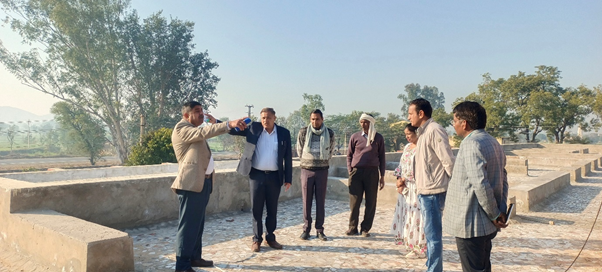
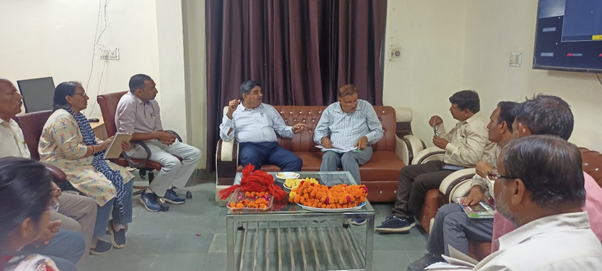
Visit of Hon'ble Vice Chancellor Prof. Balraj Singh
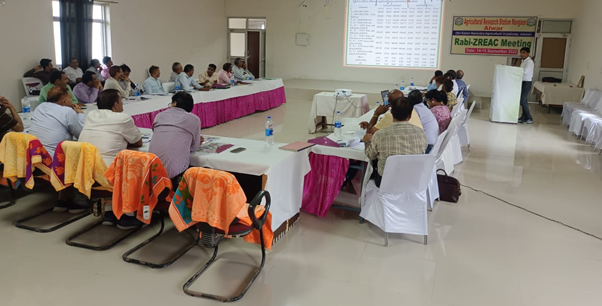
Zonal Research and Extension Advisory Committee meeting
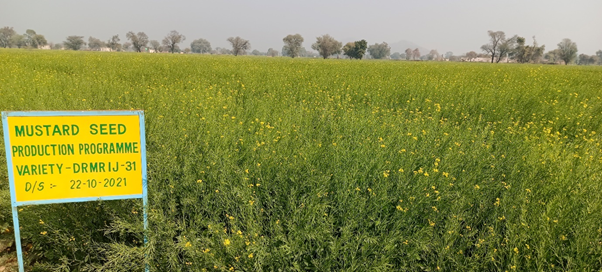
Seed production of Indian Mustard
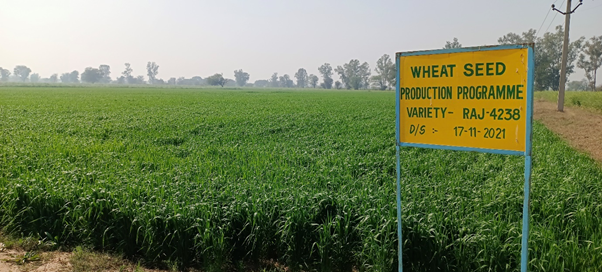
Seed production of wheat






